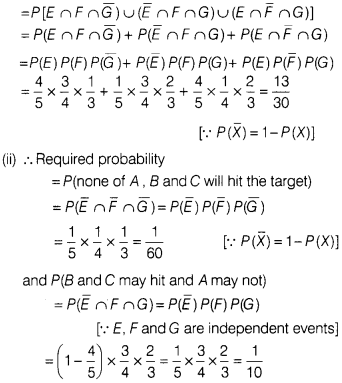CBSE Sample Papers for Class 12 Maths Set-9
Class 12thCBSE Sample Papers for Class 12 Maths Set-9
CBSE Sample Papers for Class 12 Maths Set 9 with Solutions
Time Allowed: 3 Hours
Maximum Marks: 80
General Instructions:
- This question paper contains – five sections A, B, C, D and E. Each section is compulsory. However, there are internal choices in some questions.
- Section A has 18 MCQ’s and 02 Assertion-Reason based questions of 1 mark each.
- Section B has 5 Very Short Answer (VSA) type questions of 2 marks each.
- Section C has 6 Short Answer (SA) type questions of 3 marks each.
- Section D has 4 Long Answer (LA) type questions of 5 marks each.
- Section E has 3 source based/case/passage based/intergrated units of assessment (4 marks each) with sub-parts.
Section
A
(Multiple Choice Questions)
Each question carries 1 mark
Question 1.
The value of projection of the line joining the points (3, 4,
5) and (4, 6, 3) on the line joining the points (-1, 2, 4) and (1, 0, 5) is
(a) \(\frac{4}{3}\)
(b) \(\frac{3}{4}\)
(c) \(\frac{1}{3}\)
(d)
\(\frac{2}{3}\)
Solution:
(a) The direction ratios of the line joining
P(-1, 2, 4) and 0(1, 0, 5) are proportional to (2, -2, 1), i.e.
\(2\hat{i}-2\hat{j}+\hat{k}\).
and the direction ratio of the line joining
4(3, 4, 5) and 6(4, 3 3)are proportional to (1, 2, -2),
i.e.\(\hat{i}+2\hat{j}-2\hat{k}\).
Thus, the projection of line \(\vec{AB}\) on \(\vec{PQ}\) is
Question 2.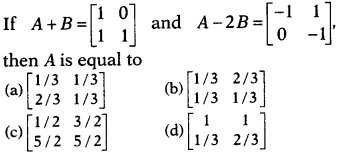
Solution: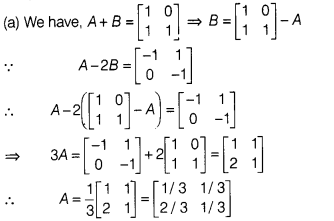
Question 3.
one of the following is correct
(a) f(x) is continuous at
x = 0 for any value of X
(b) f(x) is discontinuous at* =0 for any value of
X
(c) f(x) is discontinuous atx = 1 for any value of X
(d) None of the
above
Solution:![]()
⇒ f(x) is discontinuous at x = 0 for any value of λ.
Question 4.
The function f(x) = 4sin x-6sin2 x + 12 sin x +100 is
strictly.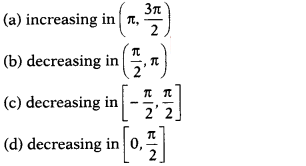
Solution:
(b) We have, f(x) = 4sin³x – 6sin²x + 12sinx +
100
∴ f'(x) = 12sin² x.cos x – 12sin x.cos x + 12cosx
= 12 [sin²x . cosx –
sin x .cos x + cos x]
= 12cos x [sin² x – sin x + 1]
⇒ f'(x) = 12cos x
[sin²x + (1 – sin x)] ∵ 1-sin x ≥ 0 and sin2 x ≥ 0
∴ sin²x + 1 – sin x ≥
0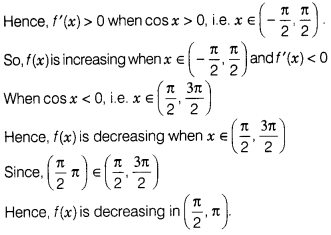
![]()
Question 5.
The magnitude of greater diagonal of parallelogram whose sides
are \(\hat{i}+\hat{j}-2\hat{k}\) and \(-2\hat{i}+3\hat{j}+4\hat{k}\), is
(a)
√21
(b) √31
(c) 21
(d) 31
Solution: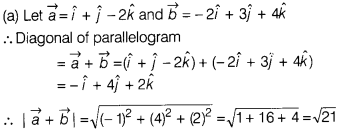
Question 6.
Solution: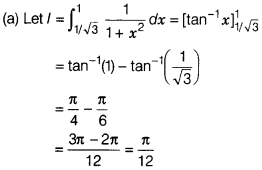
Question 7.
The area of the region bounded by the curve x = 2y + 5 and the
lines y = 2, y = -2 is
(a) 10 sq units
(b) 15 sq units
(c) 25 sq
units
(d) 20 sq units
Solution: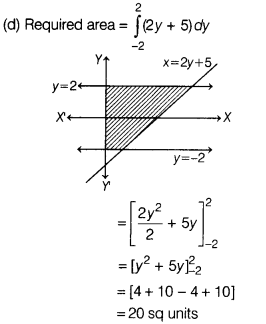
Question 8.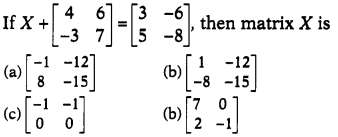
Solution: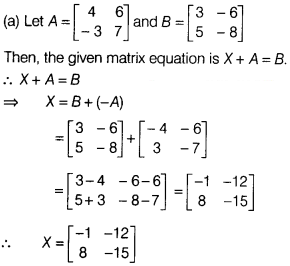
Question 9.
If \(\vec{a}=4\hat{i}-\hat{j}+\hat{k}\) and
\(\vec{b}=2\hat{i}-2\hat{j}+\hat{k}\), then |\(\vec{a}-\vec{b}\)| is equal
to
(a) √3
(b) √5
(c) 5
(d) 3
Solution: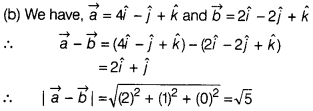
Question 10.
Then, which of the following is true?
(a) f is
differentiable at x = 1 but not at x = 0
(b) f is neither differentiable at x
= 0 nor at x = 1
(c) f is differentiable at x = 0 and at x = 1
(d) f is
differentiable at x = 0 but not at x = 1
Solution:
(d) We observe
that,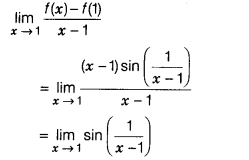
An oscillating number between -1 and 1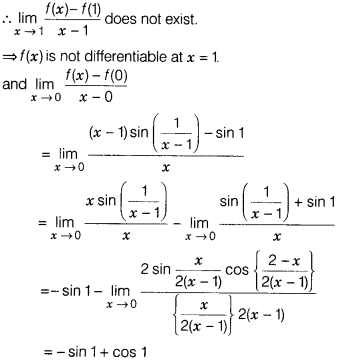
∴ f(x) differentiable at x = 0
Question 11.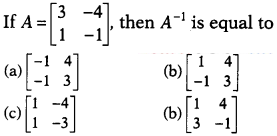
Solution: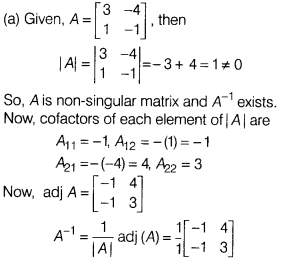
Question 12.
If Aij is the cofactor of the element
aij, of
value of a32. A32 is
(a) 100
(b)
225
(c) 110
(d) 150
Solution: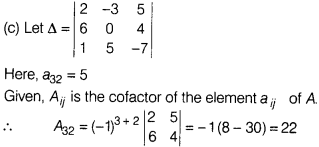
Question 13.
The family y = Ax + A³ of curves is represented by
differential equation of degree
(a) 1
(b) 2
(c) 3
(d) 4
Solution:
(a) Given that, y = Ax + A³
Here, equation has only one
arbitrary constant.
Therefore, the order of differential equation is 1.
Question 14.
The function f(x) = xx has a stationary point
at
(a) x = e
(b) x = \(\frac{1}{e}\)
(c) x = 1
(d) x = √e
Solution:
(b) We have, f(x) = xx
Let y = xx
and
log y = xlog x
∴ \(\frac{1}{y}.\frac{dy}{dx}\) = x.\(\frac{1}{x}\) + log x .
1
⇒ \(\frac{dy}{dx}\) = (1 + log x).xx
∴ \(\frac{dy}{dx}\) =
0
⇒ (1 + logx).xx = 0 ⇒ log x = -1
⇒ log x = log e-1
⇒ x = e-1
⇒ x = \(\frac{1}{e}\)
Hence, f(x) has a stationary
point at x = \(\frac{1}{e}\)
Question 15.
If \(\vec{a}\) is a unit vector such that
\(\vec{a}\times\hat{i}=\hat{j}\), then \(\vec{a}.\hat{i}\) is equal to
(a)
1
(b) 0
(c) -1
(d) \(\hat{i}\)
Solution:
Question 16.
The angle between the vectors \(\vec{a}\times\vec{a}\) and
\(\vec{b}\times\vec{a}\) is
(a) –\(\frac{\pi}{2}\)
(b) π
(c)
\(\frac{\pi}{2}\)
(d) \(\frac{3\pi}{2}\)
Solution:
(b) We know that
\(\vec{b}\times\vec{a}\) = -(\(\vec{a}\times\vec{b}\))
So, angle between
\(\vec{a}\times\vec{b}\) and \(\vec{b}\times\vec{a}\) is π.
Question 17.
The function = \(\frac{4-x^2}{4x-x^3}\)
(a) discontinuous
at only one point
(b) discontinuous at exactly two points
(c)
discontinuous at .exactly three points
(d) None of the above
Solution: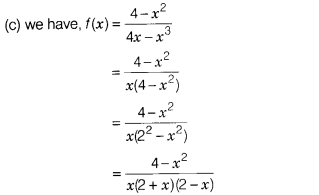
Clearly, f(x) is discontinuous at exactly three points
x =
0, x = -2 and x = 2.
Question 18.
If \(\vec{b}\) is a unit vector such that
(\((\vec{a}+\vec{b}).(\vec{a}-\vec{b})\) = 8, then |\(\vec{a}\)| is equal to
(a) 1
(b) 2
(c) 3
(d) 4
Solution: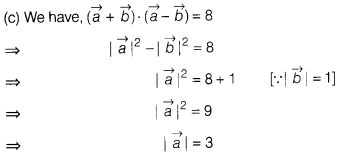
Assertion-Reason Based Questions
In the following questions, a statement
of Assertion (A) is followed by a statement of Reason (R). Choose the correct
answer out of the following choices.
(a) Both A and R are true and R is the
correct explanation of A
(b) Both A and R are true but R is not the correct
explanation of A
(c) A is true but R is false
(d) A is false but R is
true
Question 19.
Reason (R) The negative of a matrix is given by – A and is
defined as -A = (-1)A.
Solution:
(a) We define -A = (-1)A
Question 20.
The solution of the differential equation
\(\frac{d^2y}{dx^2}\) + y = 0 is y = Φ(x) a sin(x + b).
Assertion (A) The
function y = Φ(x) is called general solution.
Reason (R) The solution which
contains arbitrary constants, is called general solution.
Solution:
(a)
The solution which contains arbitrary constants is called the general solution
(primitive) of the differential equation.
Here, function Φ consists of two
arbitrary constants (parameters) a and b and it is called general solution of
the given differential equation,
Section
B
(This section comprises of very
short answer type questions (VSA) of 2 marks each)
Question 21.
Show that the function
f(x) = 4x³ – 18x² + 27x – 7 has
neither maxima nor minima.
Or
Show that the function f(x) =
\(\frac{x}{3}+\frac{3}{x}\) decreases in the intervals (-3, 0) ∪ (0, 3).
Solution:
We have, f(x) = 4x³ – 18x² + 27x – 7
f'(x) = 12x² – 36x + 27
f'(x) = 3(4x² – 12x + 9) = 3(2x – 3)²
On putting f'(x) = 0 ⇒ 3(2x – 3)² =
0
⇒ (2x – 3)² = 0
⇒ x = \(\frac{3}{2}\)(critical point)
Since, f'(x)
> 0 for all x < \(\frac{3}{2}\) and x > \(\frac{3}{2}\).
Hence, x =
\(\frac{3}{2}\) is a point of inflexion.
i.e. f(x) has neither a point of
maxima nor a point of minima.
Or
When, x ∈ (-3, 0) ∪ (0, 3)
f'(x) <
0
∴ f(x) is decreasing function in (-3, 0) ∪ (0, 3).
Question 22.
If cosec-1x + cosec-1y +
cosec-1z = \(\frac{-3\pi}{2}\),
find the value of
\(\frac{x}{y}+\frac{y}{z}+\frac{z}{x}\).
Solution: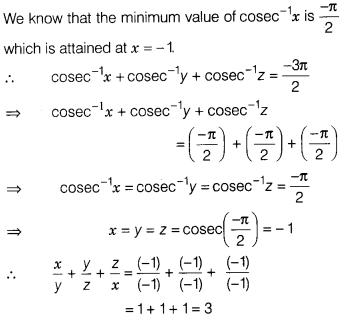
Question 23.
knd [P(B / A) + P( A / B)l if P( A) = \(\frac{3}{10}\), P(B)
= \(\frac{2}{5}\) and P(A ∪ B) = \(\frac{3}{5}\).
Or
Three distinct
numbers are chosen randomly from the first 50 natural numbers. Find the
probability that all the three numbers are divisible by both 2 and 3.
Solution: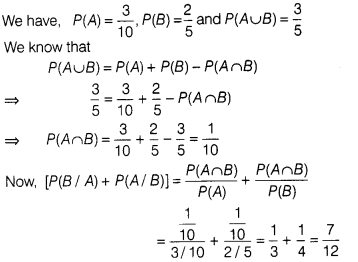
Or
Three distinct numbers can be chosen from first 50
natural numbers in 50C3 ways.
Total numbers which is
divisible by 2 and 3 from first 50 natural numbers is
{6, 12, 18, 24, 30,36,
42, 48} = 8
Question 24.
Find the angle between vectors
\(\vec{a}=\hat{i}-\hat{j}+\hat{k}\) and \(\vec{b}=\hat{i}+\hat{j}-\hat{k}\).
Solution: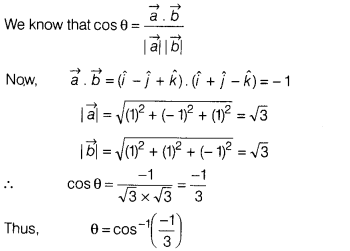
Question 25.
Three cards are drawn successively without replacement from a
pack of 52 well-shuffled cards. What is the probability that first two cards are
king and the third card drawn is an ace?
Solution:
Since, there are 52
cards in a pack.
∴ n(S) = 52
Let A = event that the card drawn is king and
B = event that the card drawn is an ace.
Now, P(A) = \(\frac{4}{52}\)
P(\(\frac{A}{A}\)) = Probability of drawing second king when one king has
already been drawn
= \(\frac{3}{51}\) [∵ remaining cards are (52 – 1) =
51]
P(B/ AA) = Probability of drawing third card to be an ace when two kings
have already been drawn = \(\frac{4}{50}\)
Now, probability of getting first two cards are king and third card is an
ace
= P(A ∩ A ∩ B) = P(A).P(\(\frac{A}{A}\)).P(\(\frac{B}{AA}\))
[by
multiplication theorem]
=
\(\frac{4}{52}\times\frac{3}{51}\times\frac{4}{50}\)
= \(\frac{2}{5525}\)
Section
C
This section comoprises of
short answer type questions (SA) of 3 marks each
Question 26.
If x, y, z ∈ [-1, 1] such that sin-1 x +
sin-1 y + sin-1 z = \(\frac{3\pi}{2}\), find the value of
x² + y² + z².
Solution:
We know that, the minimum value of
sin-1 x for x ∈ [-1, 1] is – π/2.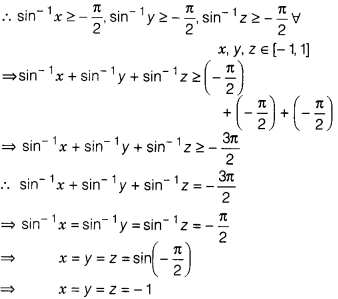
Hence, x² + y² + z² = (-1)² + (-1)² + (-1)² = 3
Question 27.
Show that the function f : R → R defined by f(x) = 2x³ – 5,
is a bijective function.
Or
If R1 and R2 be two
equivalence relations on a set A, prove that R1 ∩ R2 is
also an equivalence relation on A.
Solution:
Given, f : R → R defined by f
(x) = 2x³ – 5
For one-one (injective)
Let f(x1) =
f(x2), ∀ x1, x2 ∈ R
⇒ 2x³1 – 5 =
2x³2 – 5
⇒ 2x³1 = 2x³2
⇒ x³1 =
x³2 ⇒ x1 = x2
Thus, f(x1) =
f(x2) ⇒ x1 = x2
So, f is one-one
(injective).
For onto (surjective)
Let y be an arbitrary element of R
(codomain), then
f(x) = y
⇒ 2x³ – 5 = y
⇒ 2x³ = y + 5
⇒ x³ =
\(\frac{y+5}{2}\)
⇒ x = (\(\frac{y+5}{2}\))1/3
Clearly, x ∈ R (domain), ∀ y ∈ R (codomain).
Thus, for each y ∈ R
(codomain) there exists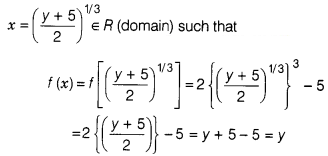
This shows that every element in the codomain has its pre-image in the
domain.
So, f is onto (or f is surjective).
Thus, f is both one-one and
onto (or both injective and surjective). Hence, f is bijective.
Hence
proved.
Or
Let R1 and R2 be two equivalence
relations on a set A.
Then, R1 ⊆ A × A, R2 ⊆ A × A ⇒
(R1 ∩ R2) ⊆ A × A.
So, (R1, ∩ R2)
is a relation on A
This relation on A satisfies the following properties
(i) Reflexivity R1 is reflexive and R2 is reflexive
⇒ (a, a) ∈ R1 and (a, a) ∈ R2 for all a ∈ A
⇒ (a, a) ∈
R1 ∩ R2 for all a ∈ A
⇒ R1 ∩ R2
is reflexive.
(ii) Symmetry Let (a, b) be an arbitrary element of R1 ∩
R2 .
Then, (a, b) ∈ R1 ∩ R2
⇒ (a, b) ∈
R1, and (a, b) ∈ R2
⇒ (b, a) ∈ R1, and (b,
a) ∈ R2 [∵ R1, is symmetric and R2 is
symmetric]
⇒ (b, a) ∈ R1 ∩ R2
This shows that
R1, ∩ R2 is symmetric.
(iii) Transitivity Let (a, b) ∈ R1, ∩ R2 and (b, c) ∈
R1, ∩ R2
⇒ (a, b) ∈ R1, (a, b) ∈
R2 and
⇒ (b, c) ∈ R1, (b, c) ∈ R2
⇒ {(a,
b) ∈ R1, (b, c) ∈ R1},
and {(a, b) ∈ R2, (b,
c) ∈ R2}
⇒ {a, c} ∈ R1 and (a, c) ∈ R2 [∵
R1 is transitive and R2 is transitive]
⇒ (a, c) ∈
R1 ∩ R2
This shows that (R1, ∩
R2) is transitive.
Thus, R1, ∩ R2 is
reflexive, symmetric and transitive.
Hence, R1, ∩ R2 is
an equivalence relation.
Question 28.
If \(x\sqrt{1+y}+y\sqrt{1+x}\) = 0, (x ≠ y), then prove that
\(\frac{dy}{dx}=\frac{1}{(1+x)^2}\)
Or
If y = ex sin x, then
prove that
\(\frac{d^2y}{dx^2}-2\frac{dy}{dx}\) + 2y = 0
Solution:
To
prove \(\frac{dy}{dx}=\frac{1}{(1+x)^2}\)
Given equation is
\(x\sqrt{1+y}+y\sqrt{1+x}\) = 0,
where x ≠ y, we first convert the given
equation into
y = f(x) form.
Clearly, \(x\sqrt{1+y}=-y\sqrt{1+x}\)
On
squaring both sides, we get
⇒ x²(1 + y) = y² (1 + x)
⇒ x² + x² y = y² +
y²x
⇒ x² – y² = y²x – x²y
⇒ (x – y)(x + y) = -xy (x – y) [∵ a² – b² = (a –
b)(a + b)]
⇒ (x – y) (x + y) + xy (x – y) = 0
⇒ (x – y) (x + y + xy) =
0
Either x – y = 0 or x + y + xy = 0
Now, x – y = 0 ⇒ x = y
But it is
given that x ≠ y.
So, it is a contradiction.
∴ x – y = 0 is rejected.
Now consider, y + xy + x = 0
y (1 + x) = -x ⇒ y = \(\frac{-x}{1+x}\)
On
differentiating both sides w.r.t. x, we get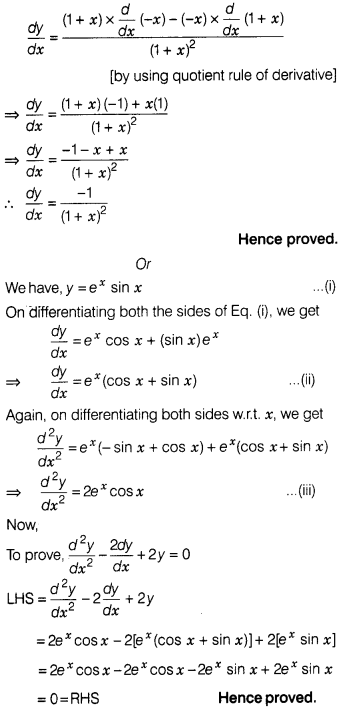
Question 29.
Evaluate ∫\(\frac{1}{3x^2+5x+7}\)dx.
Or
Evaluate
∫\(\frac{xe^x}{(x+1)^2}\)dx.
Solution: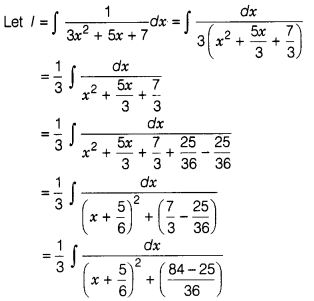
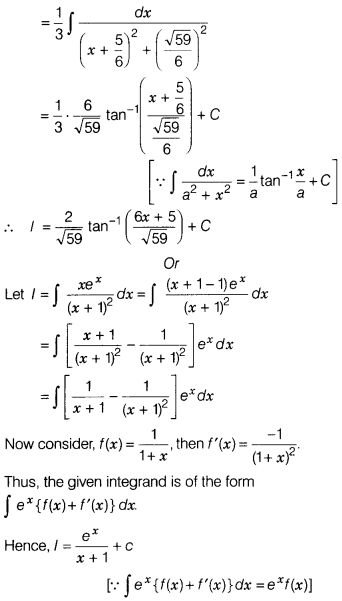
Question 30.
If \(\vec{a}\) and \(\vec{b}\) are unit vectors, then find
the angle between \(\vec{a}\) and \(\vec{b}\), given that (√3\(\vec{a}-\vec{b}\)
– b) is a unit vector.
Solution: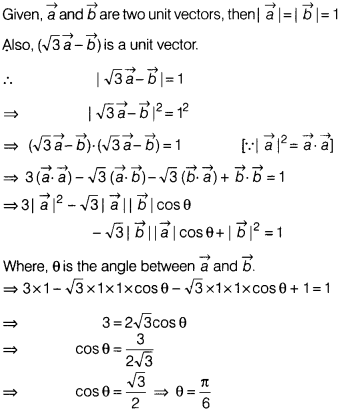
Hence, the required angle between \(\vec{a}\) and \(\vec{b}\)
is \(\frac{\pi}{6}\).
Question 31.
Find the angle between the lines whose direction cosines are
given by the equations 3l + m + 5n = 0,
6mn – 2nl + 5lm = 0.
Solution:
The given equations are
3l + m + 5n = 0 … (i)
and 6mn – 2nl + 5lm = 0
…(ii)
Now, from Eq. (i), wegetm = – 3l – 5n … (iii)
On substituting m =
-3l – 5n in Eq. (ii), we get
6(-3l – 5n)n – 2nl + 5l(-3l – 5n) = 0
⇒ 30n²
+ 45ln + 15l² = 0
⇒ 2n² + 2ln + nl + l² = 0
⇒ 2n(n + l)+ l(n + l) = 0
⇒
(n + l)(2n + l) = 0
⇒ Either l = -n or l = – 2n
If l = -n,then m = -2n
[using Eq. (iii)]
and if l = — 2n, then m = n [using Eq. (iii)]
Thus, the
direction ratio of two lines are proportional to (- n, -2n, n) and (-2n, n, n)
i.e. (-1, -2, 1) and (-2, 1, 1) respectively.
Now, let 0be the acute angle between the lines, then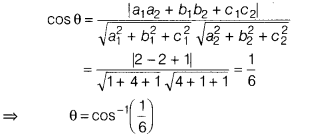
Section
D
This section comprises of long
answer type questions (LA) of 5 marks each
Question 32.
Two schools P and Q want to award their selected students on
the values of Discipline, Politeness and Punctuality.
The school P wants to
award ₹ x each, ₹ y each and t z each for the three respective values of its 3,
2 and 1 students with a total award money of ₹ 1,000. School Q wants to spend ₹
1,500 to award its 4, 1 and 3 students on the respective values (by giving the
same award money for the three values as before). If the total amount of award
for one prize on each value is ₹ 600. Using matrices, find the award money for
each value. Apart from the above three values, suggest one more value of
awards.
Solution:
₹x. ₹y and ₹z each are award to the selected students on
the values of Discipline, Politeness and Punctuality.
According to the given
conditions,
3x + 2y + z = 1000
4x + y + 3z = 1500
and x + y + z =
600
On representing the obtained equations in the matrix form, we get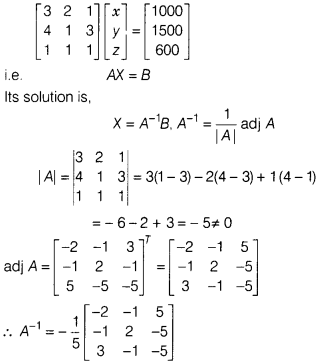
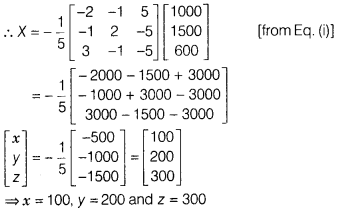
Question 33.
Find the particular solution of the differential
equation
Or
Solve the following differential equation
Solution:
Given, differential equation is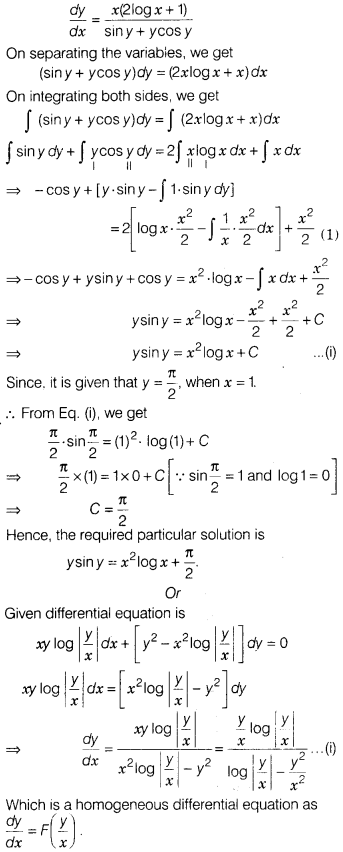
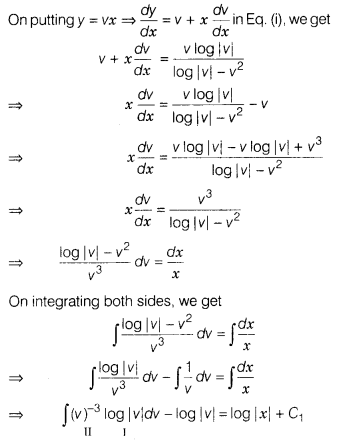
Using integration by parts, we get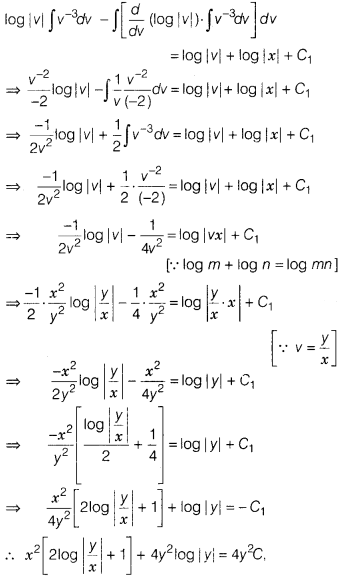
where C = – C1,
which is the required
solution.
Question 34.
Solve the LPP, maximise, Z = 0.08x + 0.10y
Subject to the
constraints, x + y ≤ 12000, x ≥ 2000, y ≥ 4000, x ≥ 0, y ≥ 0.
Or
Solve the
following LPP graphically: Minimise and maximise Z = 5x + 2y
Subject to
constraints
-2x – 3y ≤ -6, x – 2y ≤ 2, 3x + 2y ≤ 12, -3x + 2y ≤ 3, x, y ≥
0
Solution:
The linear programming problem is
Maximise Z = 0.08x +
0.10y
Subject to the constraints
x + y ≤ 12000, x ≥ 2000, y ≥ 4000
and
x ≥ 0, y ≥ 0
Consider the constraints as equations, we get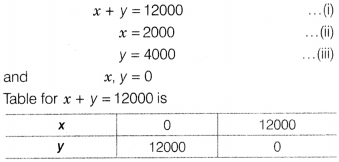
So, line passes through the points (0, 12000) and (12000, 0).
Oh putting
(0, 0) in the inequality x + y ≤ 12000, we get
0 + 0 ≤ 12000
⇒ 0 ≤ 12000
[true]
∴ The shaded region is towards the origin.
∵ Line x = 2000 is
parallel to Y-axis.
On putting (1000,0) in the inequality x ≥ 2000, we
get
1000 ≥ 2000 [false]
∴ The shaded region is at the right side of the
line,
∵ Line y = 4000 is parallel to X-axis.
On putting (0,6000) in the
inequality y ≥ 4000, we get
6000 ≥ 4000 [true]
∴ The shaded region is
above the line.
The intersection point of lines (ii) and (iii), (i) and
(iii),
(i) and (ii) are respectively,
4(2000, 4000), 6(8000, 4000) and C
(2000, 10000)
Now, plot the graph of the system of inequalities. The shaded portion ABC
represents the feasible region which is bounded.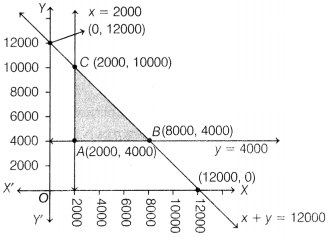
and the coordinates of the corner points are
A(2000, 4000), B(8000, 4000)
and C(2000, 10000), respectively.
Now, the values of Z at each corner point
are given below
| Corner points | Z = 0.08x + 0.10y |
| A(2000, 4000) | Z = 0.08 (2000) + 0.10(4000) = 160 + 400= 560 |
| B(8000, 4000) | Z = 0.08 (8000) + 0.10(4000)
= 640 + 400 = 1040 |
| C(2000,10000) | Z = 0.08 (2000) + 0.10(10000) = 160 + 1000 = 1160 (maximum) |
∴ Maximum value of Z is 1160 at (2000, 10000).
Or
Converting the given inequations into equations, we get
2x + 3y = 6, x –
2y = 2, 3x + 2y = 12, -3x + 2y = 3, x = 0 and y = 0
Region represented by –
2x – 3y ≤ -6:
The line – 2x – 3y = – 6 or 2x + 3y = 6 cuts OX and OY at
A1(3, 0) and B1(0, 2) respectively.
Join these points
to obtain the line 2x + 3y = 6. Since, 0(0, 0) does not satisfy the inequation –
2x – 3y ≤ – 6.
So, the region represented by – 2x – 3y ≤ -6 is that part of
XOY-plane which does not contain the origin.
Region represented by x – 2y ≤ 2: The line x – 2y = 2 meets the coordinate axes at A2(2, 0) and B2(0, -1). Join these points to obtain x – 2y = 2. Since, (0, 0) satisfies the inequation x – 2y ≤ 2, so the region containing the origin represents the solution set of this inequation.
Region represented by 3x + 2y ≤ 12: The line 3x + 2y = 12 intersects OX and
OY at A3(4, 0) and B3(0, 6). Join these points to obtain
the line 3x + 2y = 12.
Clearly, (0, 0) satisfies the inequation 3x + 2y ≤ 12.
So, the region containing the origin represents the solution set of the given
inequation.
Region represented by -3x + 2y ≤ 3: The line -3x + 2y = 3 intersects OX and OY at A4(-1, 0) and B4( 0, \(\frac{3}{2}\)). Join these points to obtain the line -3x + 2y = 3. Clearly, (0, 0) satisfies the inequation. So, the region containing the origin represents the solution set of the given inequation.
Region represented by x ≥ 0 , y ≥ 0. Clearly, XOY quadrant represents the solution set of these two inequations.
The shaded region shown in figure represents the common solution set of the
above inequations. This region is the feasible region of the given LPP.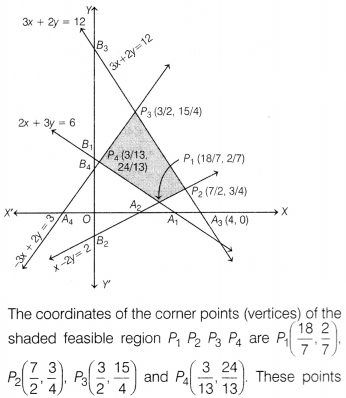
These points have been obtained by solving the equations of
the corresponding intersecting lines, simultaneously. The values of the
objective function at these points are given in the following table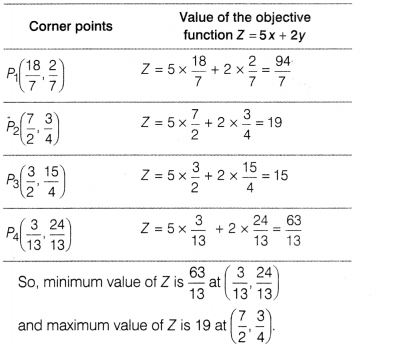
Question 35.
Show that \(\int_0^{\frac{\pi}{2}}\) f (sin 2x)sin xdx
=
√2 \(\int_0^{\frac{\pi}{4}}\) f (cos 2x)cos xdx.
Solution: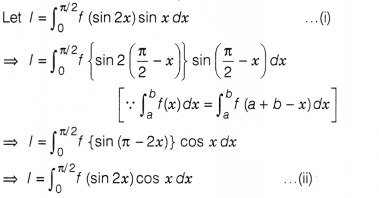
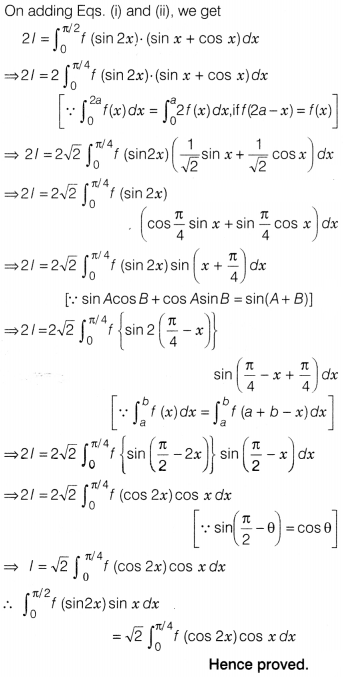
Section
E
This section comprises of 3
case-study/passage-based questions of 4 marks each
Question 36.
A square piece of tin of side 24 cm is to be made into a box
without top by cutting a square from each corner and folding up the flaps to
form a box.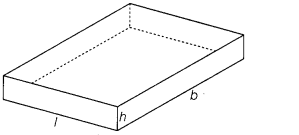
On the basis of above information, answer the following
questions
(i) Write the length, breadth and height of the box formed in terms
of x.
(ii) Express volume V of the box in terms of x.
(iii) Show that
volume of the box is maximum, when x = 4 cm.
Or
If volume of the box is
maximum at x = 4, then find the maximum value of volume of box. If rate of
making the box is ₹5/cm², then find the cost of box when volume is maximum.
Solution: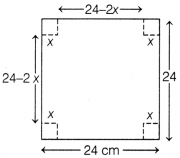
(i) From figure it is clear that
Length of box = 24 –
2x
Breadth of box = 24 – 2x
Height of box = x
(ii) Volume of box, V = length × breadth × height
= (24 – 2x)(24 – 2x) (x)
= x(24 – 2x)²
(iii) We have, V = x(24-2x)²
∴ \(\frac{dV}{dx}\) = (24 – 2x)² + 2x(24 –
2x)(- 2) dx
= (24 – 2x) [24 – 2x – 4x]
= (24 – 2x) (24 – 6x) = 6 (24 –
2x)(4 – x)
For maximum,
\(\frac{dV}{dx}\) = 0
⇒ 6(24 – 2x)(4 – x) =
0
⇒ x = 4 and x = 12
Again, \(\frac{d^2V}{dx^2}\) = 6[-2(4 – x) + (24 –
2x)(- 1)]
= 6 [-8 + 2x – 24 + 2x] = 6[4x – 32]
∴
\(\frac{d^2V}{dx^2}\)|x=4 < 0 and
\(\frac{d^2V}{dx^2}\)|x=12 >0
So, V is maximum at x = 4
Or
∵ Volume of box, V = x(24 – 2x)²
∴ Vmax = x(24 – 2x)²
= 4(24
– 8)² = 4 × 16² = 1024cm³
Length of box = 24 – 2x = 24 – 2 × 4 = 16cm,
Breadth of box = 24 – 2x = 24 – 2 × 4 = 16 cm
and height of box = 4 cm
∴
Surface area of box = 2(l + b)h + lb
= 2(16 + 16) × 4 + 16 × 16 = 256 + 256 =
512 cm²
∴ Total cost of making the box = 512 × 5
= ₹2560
Question 37.
If f(x) is a continuous function defined on [-a, a],
then
A function f(x) is even , when f(-x) = f(x) and odd when
f(-x) = -f(x).
On the basis of above information, answer the following
questions
(i) If f(x) is an even function, then evaluate \(\int_{-1}^1\)f(x)
-f(-x))dx.
(ii) If g(x) is an odd function, then evaluate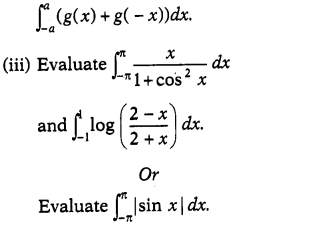
Solution: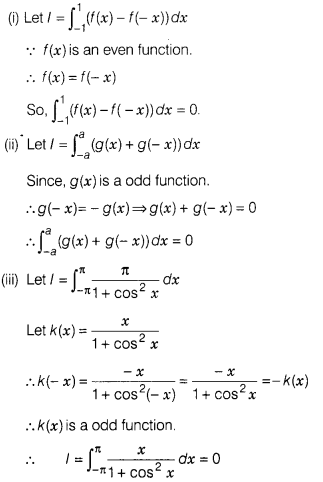
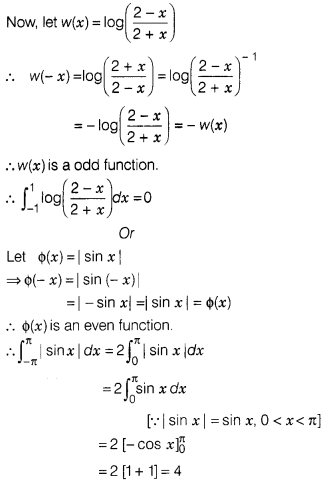
Question 38.
A can hit a target 4 times in 5 shots, B hit 3 times in 4
shots and C hit 2 times in 3 shots.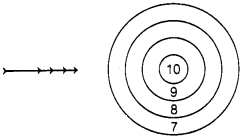
On the basis of above information, answer the following
questions
(i) Find P(any two of A, B and C will hit the target).
(ii) Find
P(none of them will hit the target) and P (B and C may hit and A may not).
Solution:
Consider the following events,
E = A hits the target,
F = B
hits the target
and G = C hits the target
(i) ∴ Required probability = P
(any two of A, B and C will hit the target)